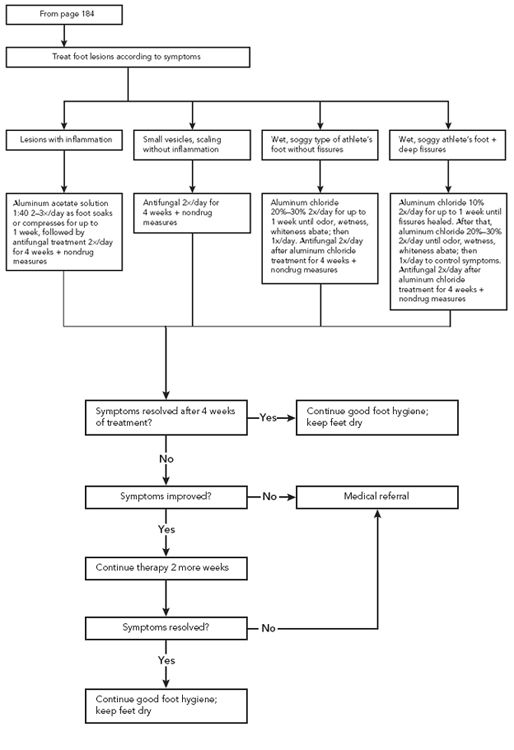 Overview
Overview
Fungal skin infections, or dermatomycoses, generally are caused by three genera of fungi: Trichophyton, Microsporum, and Epidermophyton. Members of these genera are known as dermatophytes.
The term “tinea” refers exclusively to dermatophyte infections. Most often, tinea infections are named according to the area of the body that is affected. For example, tinea capitis refers to infections of the scalp; tinea corporis refers to infections of the body; tinea cruris refers to infections of the groin; tinea pedis refers to infections of the feet; and tinea unguium refers to infections of the nails.
Tinea infections may be better known by their common names. Tinea corporis is known as ringworm because the characteristic lesions are ring-shaped with clear centers and red, scaly borders. Tinea capitis is known as ringworm of the scalp; tinea unguium is known as ringworm of the nails. Tinea cruris is “jock itch.” Tinea pedis is athlete’s foot.
Tinea capitis and tinea unguium are not amenable to self-treatment. In patients with tinea unguium, the affected nail must be treated with systemic drug therapy (e.g., terbinafine or itraconazole) or removed surgically to rid the area of the offending fungus.
 Epidemiology
Epidemiology
- An estimated 10%–20% of the U.S. population suffer from a tinea infection at any one time.
- When exposure to infectious environments is equal, the incidence of tinea infections in women approaches that in men.
- Tinea pedis (athlete’s foot) is the most prevalent cutaneous fungal infection in humans. It afflicts approximately 26.5 million people in the United States every year. An estimated 70% of people will be afflicted with athlete’s foot in their lifetime; approximately 45% will suffer with it episodically for more than 10 years.
- Of every 10 people with athlete’s foot, 7 are male.
- Although tinea pedis may occur at all ages, it is more common in adults, presumably because of their increased opportunities for exposure to pathogens.
- Tinea pedis is rare among blacks but common in whites, particularly those who live in urban tropical areas.
- Of every 10 people with athlete’s foot, 7 are male.
- Tinea corporis is most common in prepubescent individuals. It frequently is transmitted among children in day care centers as well as children who participate in contact sports (e.g., wrestling).
- Tinea corporis is more common in both adults and children who live in hot, humid climates.
- Individuals who are under stress or overweight also are at increased risk for the development of tinea corporis.
- Tinea corporis is more common in both adults and children who live in hot, humid climates.
- Tinea cruris occurs more often in men than in women and rarely affects children.
- Tinea cruris is most common during warm weather, but it can occur at any time of the year when the skin in the groin area stays warm and moist for long periods of time (e.g., prolonged contact with wet clothing).
- More than 2.5 million Americans are treated annually for tinea unguium. Many cases go untreated, so the actual incidence of this infection is probably much higher.
- Tinea capitis occurs most often in children because they are more likely to have contact with infected individuals and are less attentive than adults to personal hygiene.
- Black female children are infected more often than black males and white children, possibly because of the hair care products and practices (e.g., occlusive hair dressings and tight braiding) that are unique to this population.
 Etiology
Etiology
- Fungal transmission can occur through contact with infected people; animals (e.g., infected cats or dogs); soil; or fomites (e.g., infected towels, clothing, hats, toys, or telephones).
- Most tinea infections are caused by person-to-person contact with infected individuals.
- Trauma to the skin—especially trauma that produces blisters (e.g., from wearing ill-fitting footwear)—may be significantly more important to the occurrence of human fungal infections than is simple exposure to the offending pathogens.
- Environmental factors contribute to the development of tinea infections.
- Footwear is a key variable, as illustrated by the incidence of tinea pedis in any population that wears occlusive footwear, especially in the summer and in tropical or subtropical climates. Shoes (especially tight-fitting shoes) promote warmth and sweating, which encourage fungal growth.
- Similarly, sweating or wearing wet clothing for long periods of time can predispose individuals to the development of tinea corporis and tinea cruris.
- Individuals who use public pools or bathing facilities are at greater risk for tinea pedis than the general population.
- Footwear is a key variable, as illustrated by the incidence of tinea pedis in any population that wears occlusive footwear, especially in the summer and in tropical or subtropical climates. Shoes (especially tight-fitting shoes) promote warmth and sweating, which encourage fungal growth.
- Chronic health problems (e.g., diabetes and HIV infection) and medications that weaken or suppress the immune system (e.g., glucocorticoids) can increase the risk for development of tinea infections.
- Other predisposing factors for the development of tinea infections include impaired circulation; poor nutrition and hygiene; occlusion of the skin; and warm, humid climates.
 Signs and Symptoms
Signs and Symptoms
- The most common complaint of patients with a cutaneous fungal infection is pruritus.
- Patients may experience painful burning and stinging if fissures are present, particularly between the toes.
- Weeping or oozing may occur in areas that are abraded, denuded, or inflamed. These areas also may be painful.
- Patients may experience painful burning and stinging if fissures are present, particularly between the toes.
- General characteristics of tinea infections are listed in Table 1.
TABLE 1. General Characteristics of Fungal Skin Infections
| Description |
Location | On areas of the body where excess moisture accumulates, such as the feet, groin area, scalp, and under the arms |
Signs | Presents either as soggy, malodorous, thickened skin; acute vesicular rash; or fine scaling of affected area with varying degrees of inflammation Cracks and fissures also may be present |
Symptoms |




